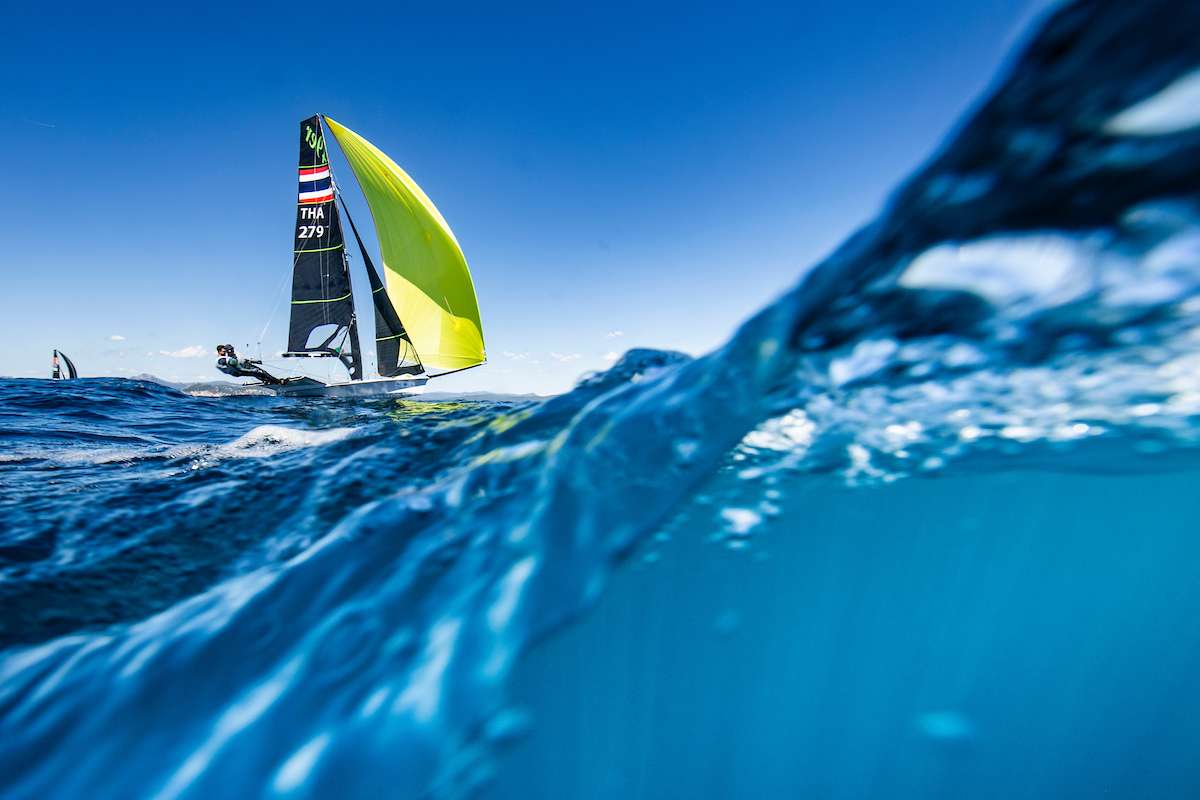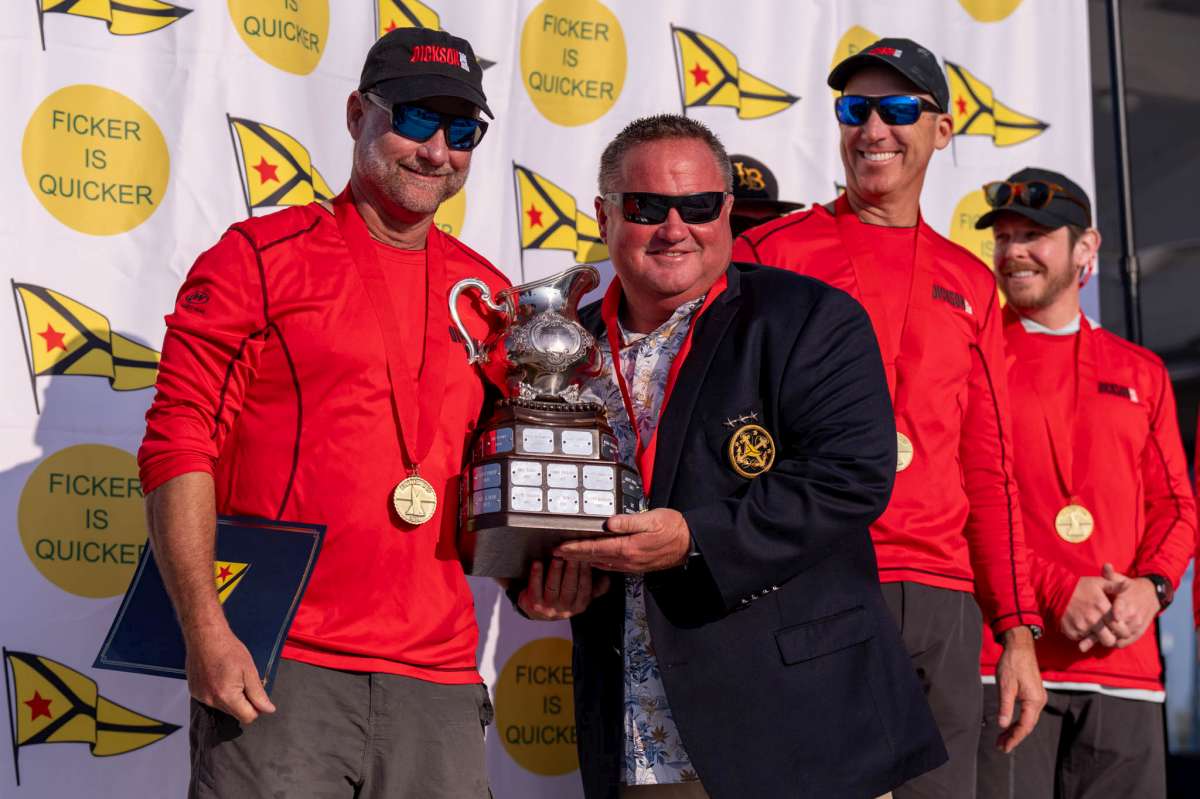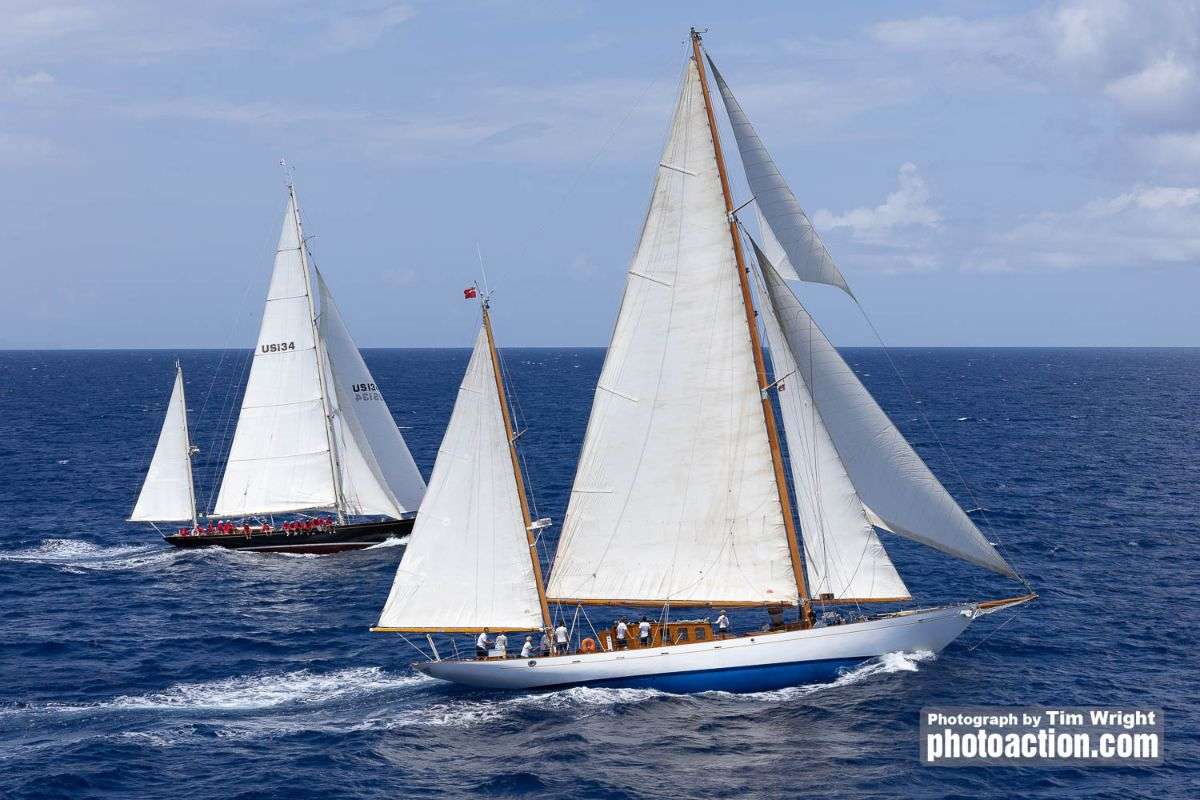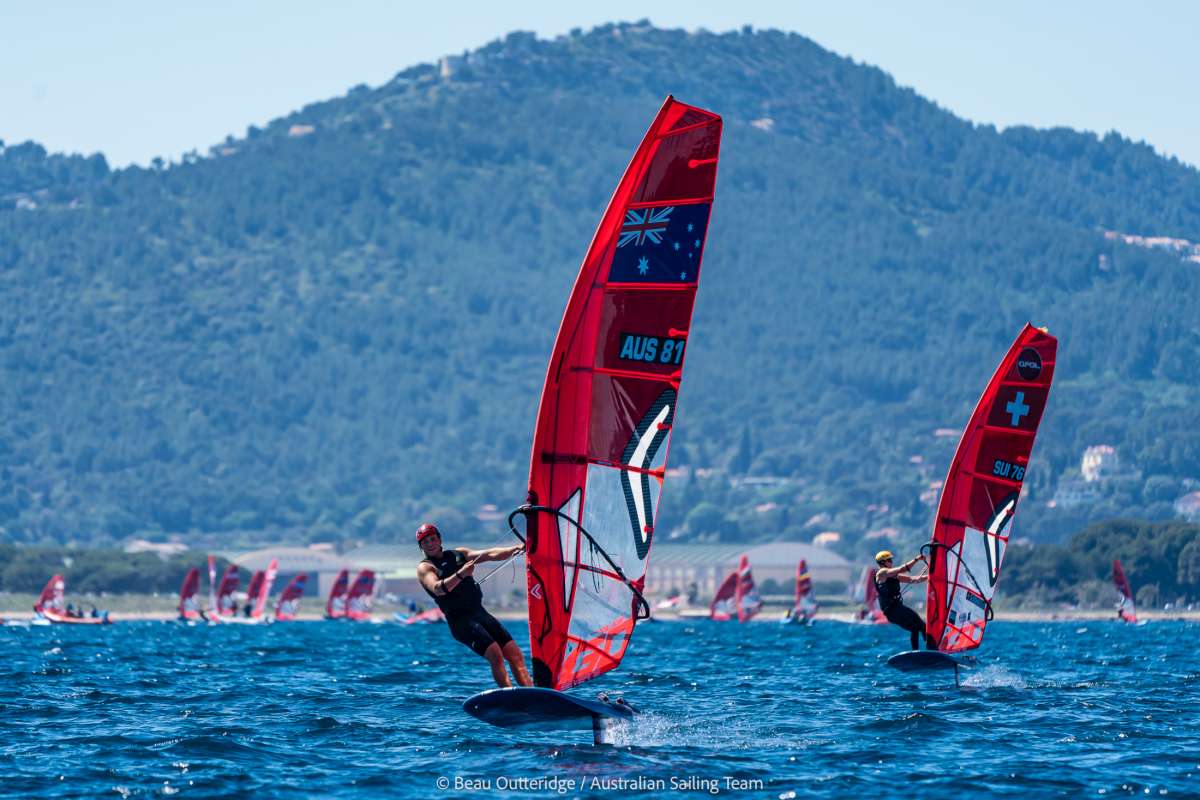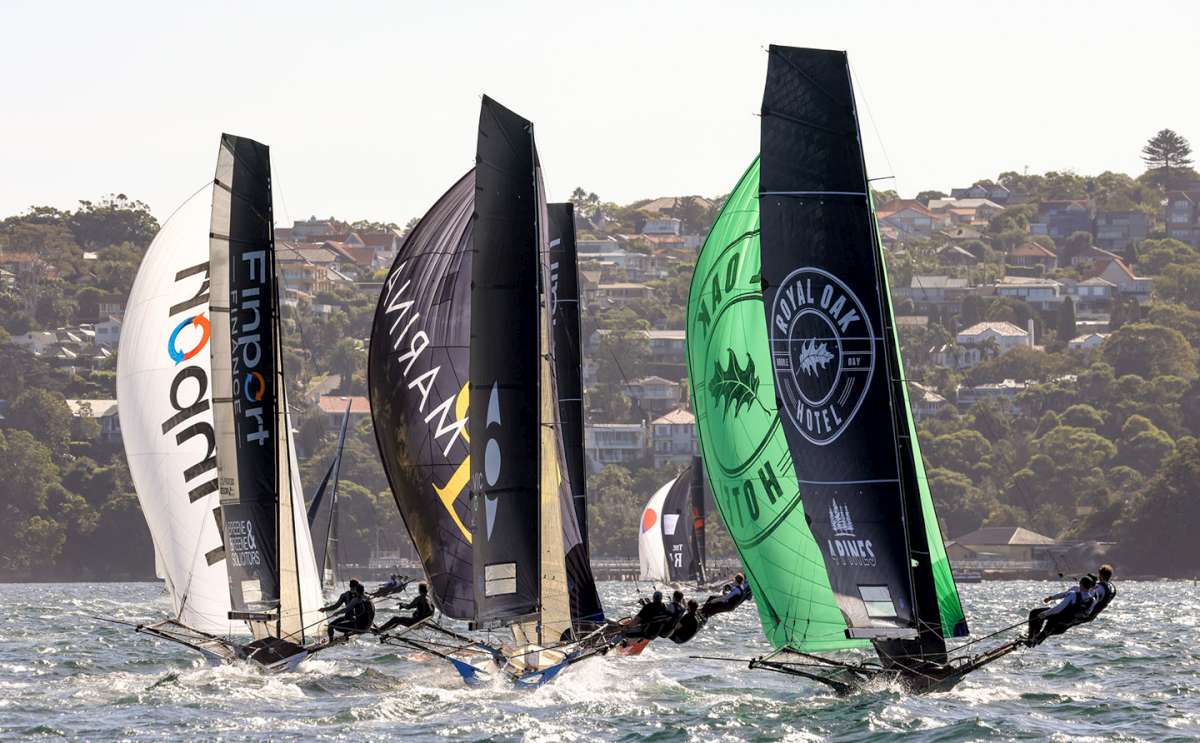NORTH Sails for two years has been working on a new membrane sail-fabric technology that, when ready, will revolutionise sailmaking in the same way that its 3DL three-dimensional laminating process did 20 years ago, says Michael Coxon, managing director of North Sails Australia.
Dimension-Polyant, another major player in the continuing search for the strongest, low-stretch, lightest sail material, has found a way to use stronger-than-steel Dyneema in its D4 laminates.
Meantime in a shake-up of Australian sailmaking alliances, Ray Roberts’ Sydney loft and other lofts throughout Australia and New Zealand, have quit the Quantum Design Group to form an alliance with the US-based Evolution membrane manufacturer.
Carl Crafoord, who served an apprenticeship in Sydney with Hughie Treharne’s Sydney loft 32 years ago, has returned to sailmaking after being involved with distributing Harken and Lewmar yacht hardware, to form Quantum Sails Australasia Ltd and to market Quantum’s products in a new way.
North’s 3Di
The development of 3Di began in Switzerland with the Alinghi team looking into all aspects of its sail program building sails using the ultra-strong PBO fibre. When the Cup was over, the North Sails group bought the research, seeing a development pathway for it through its 3DL process. “It was still very conceptual but we could see the potential there” said Michael Coxon.
About the same time that the team of about ten people who had been working on the development for Alinghi joined the staff of the 3DL factory in Nevada, USA, North acquired Cuben Fibre, producer of a sailcloth originally developed for Bill Koch’s America’s Cup winning campaign of 1992 with America Cubed.
North has been working on 3Di for two years and Coxon said it may take another six months of development before 3Di will be ready for general launch on the sailmaking market. It is currently being tested by selected owners and professional sailors.
Neville Crichton, with Coxon as his tactician, successfully tried 3Di sails on his R/P 72 Alfa Romeo 3 in the Maxi Yacht Rolex Cup regatta at Porto Cervo in September. Crichton won the owner/driver prize in the mini/maxi division and Alfa Romeo 3 finished second in the open mini/maxi class.
The 3Di process still uses the 3DL adjustable moulds at the Nevada factory to fully shape a sail. But it has eliminated the Mylar base panels draped over the moulds to which, in 3DL, the structural threads are laid. Mylar is not load-bearing; it mainly just stops the wind from blowing through the membrane.
Instead of threads of twisted fibre, hair-like individual fibres (about half the size of a human hair) of the structural material are laid parallel and formed into extremely thin (35 microns) strips of filaments. The strips, 400mm long by 100mm wide, are pre-impregnated with resin adhesive and a backing of paper to allow the tape to be handled. If one fibre fails through damage or mishandling, hundreds of fibres alongside it are ready to take up the load.
The parallel construction of the tapes means there is no stretch-producing “crimp” that the over-and-under constructions of traditionally-woven materials have. Typical tapes are composed of carbon and Dyneema (Spectra) fibres with the proportions of each determined by the sail designer. 3Di can use a number of different fibres to make up the end product ranging from polyester to the high-modulus fibres like Kevlar, Twaron, PBO, carbon or Spectra/Dyneema.
A plotter lays the tapes down in inter-leafing sections on a flat layout table. The tapes are so thin that the plotter can keep laying them in straight-line multiples to achieve strength needed in any particular section or direction. Reinforcement for corners and reef points are laid at the same time.
The sections of tapes are then transferred to the 3DL moulds, joined with scarf joints and bound together with a thermoset heat process.
The 3Di research has included NASA’s technology for making weather balloons in developing glues that will adhere to Spectra/Dyneema. “It is very hard to glue anything to it,” says Coxon.
Because 3Di has strength to resist stretch in nearly all directions it claims to maintain the shape of a sail with minimal halyard, Cunningham or outhaul adjustment. North says that while the 3Di material is much stiffer than its other laminates, it can still be readily folded or rolled.
“It virtually eliminates all give in a sail so we could well see blocks and halyards fail as they did in the early days of 3DL; they will have to be stronger,” says Coxon.
North does not intend to replace 3DL or sell 3Di against it but see it as an alternative in the high end of the racing market.
Quantum/Evolution swap
Ray Roberts, owner of the Sydney and Singapore lofts that were formerly members of the Quantum Sail Design Group explained the move to Evolution: “Myself and most of the Australian affiliates, together with New Zealand, Canada and a couple of US lofts decided that we would take another direction. We decided to set up the Evolution Sail Group.
“We had an amicable parting of the ways with Quantum. We all decided we needed another direction in the sailmaking industry; one that allowed us more choice of membranes.”
Roberts said that besides using the membranes being custom-created by Annapolis-based Evolution in the USA, the group would also be working with Dimension-Polyant on membrane designs. “We are developing our own range of products and will offer sails using Dimension-Polyant or our own in-house membranes produced in the USA.”
Roberts, who is a member of the group’s management team, said Evolution had its own sail-design team with Graeme Robbins in New Zealand, Geoff Couell and Ben de Coster from Evolution Sydney and Scott Gibbs in Annapolis, USA.
“We are out there to compete with all the other specialist membrane sailmakers, not only in the grand prix racing market but in club-racing and cruising markets as well. The price of the product will be matched to the requirements of the various owners.”
Roberts said that Evolution would also be offering a mast/sail combination tuning service to yacht owners headed by Don Buckley and Steve McConaghy.
Carl Crafoord, the new managing director of Quantum Sails Australasia, has a vision for marketing sails. His goal is to have various outlets selling sails from a central manufacturing source into every segment of the market – club racing, IRC offshore, multihull, cruising, one design, dinghies, juniors – while having Quantum service centres in each capital city and other popular locations to handle sail repairs and maintenance.
The centres will also have allied sailing services, like custom quality canvas goods, rigging and retail products including kids’ sailing equipment, communications and navigation equipment.
Quantum Australia will have a uniform national price list and customers will be able to have their sails repaired and serviced at any Quantum service centre, regardless of where they bought the sails.
Crafoord has been in the marine industry for 32 years since he began a sailmaking apprenticeship with Hugh Treharne in Sydney in 1976. Most recently, he headed Lewmar Australia, after previously handling Harken Yacht Equipment’s distribution in Australia. Lewmar, in a global economic rationalisation in May, closed Lewmar Australia while keeping a direct relationship with regional distributors.
What attracted him to Quantum? “The sailmaking industry is facing rapid change at this time and the Quantum model is the future; proprietary central manufacturing, winning designs and global distribution backed up with 100 per cent commitment to customer service,” he said.
The manufacturing centre that will service Australia is in Malaysia, owned by the American De Vos family who are active racers.
David Eickmeyer’s Melbourne loft has stayed with Quantum and is running the Victorian Quantum sails and service centre while still retaining its manufacturing arm to assist with demand and quick turnarounds in supply when required.
In November Crafoord will move back into his Brookvale premises, from which he served Harken and then Lewmar, to establish a sail loft and service centre there with other retail services.
He has also established a Quantum presence at the new Sydney City Marine repair and maintenance yard on Rozelle Bay under the Anzac bridge by joining up with Quality Canvas, which will handle Quantum’s city repairs and maintenance besides providing custom canvas solutions.
“I personally find the current sailmaking model quite archaic,” says Crafoord. “Not much has changed since I did my apprenticeship with Hugh Treharne in
the 1970s. The real future of the business, like all industries, is about economies of scale and centralised manufacturing.
“It’s all about design, manufacturing, distribution, marketing and customer service. They are the five elements of the business.
“I’ve had a dozen sailmakers come to me asking if they can re-sell the product. They like the concept that we are following. They don’t have to make it but support it with their expertise.
“There’s a whole heap of smart people behind this at Quantum Inc so if the design is world standard and even tweaked for our conditions and the product is 100% deliverable at the highest quality standards, then the rest of it is about people,” Crafoord said.
To help clients get the best out of their boats, Crafoord plans to have coaching support on the water and coaching and navigation seminars.
History of membrane sails
The manufacture of membrane sails, which combine film with high-strength fibres to avoid the stretch problems in woven sailcloth, was pioneered by North Sails in 1990. Instead of using the traditional process of broad-seaming, relying on flat cloth with curved edges sewn together to achieve the three-dimensional shape of a sail, North’s 3DL (three dimensional loaded) process shapes the entire sail over a three-dimensional mould.
A base layer of Mylar film panels is draped over moulds that can be adjusted by hundreds of hydraulic jacks to shape sails of widely different cambers. The base layer panels are joined together with modest shaping to lie reasonably smoothly over the 3D surface of the mould and tensioned.
A computer-controlled overhead gantry then applies precisely-tensioned structural yarn of carbon, aramid or combinations of both, onto the surface of the base film in a pattern that matches the anticipated loads in the sail.
Once the yarns are laid, a second film, containing yarns to handle incidental loads off the primary load lines, is positioned on top of the base film and yarn, tensioned and then covered with a large vacuum bag that compresses the laminate.
The gantry head is then removed and replaced with a carbon element heat “blanket” that cures the pressurised laminate and causes it to conform tightly to the mould. The sail is allowed to cure
for more than five days before shipping and/or finishing with corner reinforcements, bolt ropes, batten pockets and protective patches applied by sailmakers.
North claims that a finished 3DL sail can be up to 30 per cent lighter than a conventional panelled or “string” sail of equivalent stretch. North admits that 3DL costs more but says that it has a longer effective racing life than the “two-dimensional” string sails.
‘String’ sails
North faced a patent battle on 3DL with Peter Conrad of Sobstad, who had also patented Genesis, which uses discontinuous fibres in panelled sails with fibres laid out according to the load path matched from panel to panel. This litigation was settled in 2002.
Meantime in Australia, free of patent restraints, sailmaker partners Bob Fraser and Brad Stephens in 1996 began developing D4 as a cost-effective alternative to 3DL.
By the middle of 1998, after exploring alternative laminations and resin systems, D4 production had reached a stable platform. In August that year Bob Steel’s Nelson/Marek 46 Quest, the first yacht to use D4 sails in an international regatta, finished second overall and top Australian yacht in the Kenwood Cup.
Recognising that D4 needed a world-wide sales network, Fraser and Stephens in 1999 signed a marketing agreement with Robbie Doyle for distribution through the Doyle Sailmakers network.
Dimension-Polyant Sailcloth in Germany, the world’s largest sailcloth manufacturer, acquired D4 from Fraser Sails in February 2004.
While Fraser retired from the business, Stephens stayed on as managing director of Dimension-Polyant Membranes which continues to produce D4 for the global market at the Somersby factory.
Sailmakers from all over the world e-mail the offsets for their custom-designed sails to Somersby. Dimension-Polyant Membranes reconstructs the shaped sections in its computer program and generates the load map for the sail.
The lower panels of the sail, made from woven taffeta, polyester Mylar film or both, are laid out flat on a construction floor. A computer-controlled overhead gantry machine places yarns on the panels in the load directions calculated precisely on an individual basis. The fabric is then covered with scrim or covered with film and taffeta to produce the finished structure.
Heat is used to activate the adhesive on the film and/or the taffeta. At the same time rollers apply several tons of pressure to the laminate while trapped air and excess adhesive is sucked off with the aid of a vacuum. Less glue means a lighter laminate. Having all the primary yarns following the load paths also saves weight over laminates that have fibres in some areas of the sails not doing anything.
The original D4s were built in individual sections; if a mainsail had five battens there would be typically six sections, with each section join/seam occurring at a batten.
A more cost-effective method evolved, using “one piece” membranes in the factory. Brad Stephens explains: “Imagine each section of the sail being slid apart so that it’s not overlapped by the seam width or seam shape. We do this virtually in the computer and this ‘exploded’ sail can be used for yarn laying.
“Yarns are laid continuously over the whole sail, which is laminated as one piece. Plotted lines representing the sailmaker’s seam shape, luff and leech curves are drawn.”
The one-piece laminated membrane goes to the sailmaker complete with batten pockets, leech reinforcement tapes and corner reinforcements. The sailmaker cuts the membrane apart along the computer-plotted sections lines and rejoins the sections along their curved edges for seam shape to give the three dimensional shape, bonding the sections together with an air-pressured glue gun.
“However, while this is cost effective it’s not necessarily the best technical solution as the yarns do not align across the seams,” says Stephens. “So we also have what we refer to as ‘expanded’ membranes. Here the trajectories are designed with all the sections overlapped but for yarn-laying purposes (again as a single work piece) the sections are separated and joined by a zig-zag path so that when the sections are rejoined by the sailmaker, all the fibres align across the seams. Naturally, these sections are separated after lamination and delivered to the sailmaker as sections.”
Other cloth manufacturers and sailmaking groups have followed the technology established by North and Dimension-Polyant in laminated sail fabric, developing their own multi-axial reinforced fabrics. These products have eliminated the need for radial orientation of panels in sails to overcome the problem of bias distortion in traditionally-woven sailcloth.
Load-bearing yarns used in “string” sails include carbon fibre, Spectra, Dyneema, Kevlar, Twaron, Vectran, Pentex and polyester. Spectra and Dyneema are the trade names for ultra high-tenacity polyethylene yarns with similar properties from different manufacturers: DSM (Netherlands) and Honeywell (USA). Taffeta is sometimes used in outside layers, instead of Mylar film, for abrasion and UV resistance, especially in cruising sails.
Membrane developments
Dimension Polyant
Latest advance in DP’s D4 technology is to incorporate the polyethylene Dyneema, the strongest fibre in the world, used in bullet-proof vests and armour plating, into its laminates for the world’s biggest yachts.
While Dyneema has been in common use in running rigging, particularly halyards, because of its low-stretch and light-weight properties, it had not been used in sail-fabric membranes because the high processing temperatures needed to flow the bonding resin threatened to melt the polyurethane and the ultra-smooth surface of Dyneema made it difficult to glue.
Dimension-Polyant has developed a new proprietary method that it says ensures a perfect bonding of the Dyneema fibre to the polyester film. The D4 Dyneema sailcloth proved itself on an Open 40 in the 4300-mile Transat Jacques Vabre race. It is being marketed towards 100ft plus cruising yachts as well as the big, high-performance, long-distance race boats.
Besides its low-stretch and strength-to-weight properties, Dyneema is claimed to have high-flex resistance against the wear and tear of repetitious folding and handling and good ageing properties. Every resin used in the D4 process contains ultra-violet inhibitors and microbial additives. Woven surface taffetas are also treated for protection from UV and mildew.
Bainbridge
Bainbridge International, one of the world’s longest-established sailmakers (founded in the USA in 1917), continues to develop new products including DIAX (diagonal axis) multi-directional laminated sailcloth.
Bainbridge says all DIAX fabrics have the ultimate combination of low stretch, light weight and excellent durability. DIAX is available with polyester, Pentex, Twaron and carbon primary fibres.
It lays the scrim fibres as flat ribbon tapes rather than round yarns to reduce thickness and improve adhesion.
All scrims are formed by a bonding process that eliminates the crimp associated with weaving, which results in stretch. The tri-axial configuration reduces “hinging”, a known cause of laminate breakdown and shrinkage. Diagonal axis ribbons resist off-threadline loads without relying on film. Specially-developed adhesives optimise bond strength with minimum weight.
Its newest DIAX2 Race range of performance laminates, developed specifically for cross-cut panel configurations, takes the DIAX concept to the next level by incorporating multiple layers of fibre within a film/film sandwich.
Two DIAX scrims of aramid Technora and Twaron laid diagonally are combined with a fill-oriented (across the cloth roll) Twaron/Technora scrim base layer to provide six primary thread lines.
The primary leech loads in a DIAX2 sail are managed by the Twaron 90-degree fill fibre in the base layer while at the luff, primary loads are handled by the 65-degree Twaron ribbons in the DIAX scrim. Mainsheet and vang loads at the base of the sail are handled by the 45-degree Technora DIAX ribbons while the warp (along the roll) Technora ribbons in the base layer resist outhaul tension as well as adding stability and durability to the whole sail.
DIAX2 Cruise uses either similar flat, untwisted, zero crimp fibre ribbons of Twaron and Technora or polyester and Pentex in its scrim, sandwiched in taffeta. Bainbridge says that on average, using DIAX2 reduces cloth wastage by 15 per cent and reduces the number of panels by up to 70 percent, allowing the sailmaker to provide durable, reliable and better value performance sails.
Contender
For cross-cut sails, Contender Sailcloth has further developed the asymmetrical fibre layout in a roll of sailcloth by adding a fifth fibre in its newly-released MAXX3 multi-axial fabric. The reverse-angle fibre, set at minus 70 degrees to the fill (weft, fibres running across the roll) is intended to absorb the tack and luff loads and eliminate the need for “flip” panels in the luff and at the tack. The existing four fibres, carried on from the MAXX2 range were set at plus 90 degrees, 82 degrees, 70 degrees and 0 degrees to the fill line.
The configuration of the yarn layout disperses and stabilises any load path throughout the sail caused by mast bend, sheeting angle and trimming. Moving the genoa lead back to flatten the foot and twist open the top of the sail will cause the load lines to migrate from the leech towards the centre of the sail. MAXX has the yarns already in place and correctly oriented to handle these changing load paths.
In a mainsail, MAXX3 will allow sailmakers to place the crosscut panels parallel to the boom. In all sails, says Contender, MAXX3 all-purpose cloth will provide unprecedented stability both on and off the fill thread line for loads running up the leech and into the body of the sail.
MAXX fabric is available in six styles with one of them, Voyager, having polyester taffeta sandwiching the aramid carbon scrim and film, suitable for cruising as well as racing yachts. Four others have varying combinations of film and/or taffeta with the carbon scrim load-bearing threads while the sixth, Euro Pen, is for performance classes where carbon or aramid fibres cannot be used in sails.
Contender says MAXX technology creates a durable cloth with enhanced fibre life and reduced shrinkage for a longer lasting sail. The fabric is soft, making it easy to handle and stow while the multiple angles of the laminates increases tear resistance and durability of the sail.
Quantum
Quantum describes its Fusion M membrane product as an adaptable “smart sail” structure that integrates loadings throughout the whole sail so that loadings are shared evenly.
Sails made of Fusion M are not “load path”, says Quantum. They utilise an integrated fibre network that addresses sail loadings as a whole instead of attempting to place fibre as efficiently as possible along the primary load paths.
Fusion M’s complex dense fibre matrix allows each part of the structural system to support the rest, keeping any one part of the sail from becoming overloaded and distorted. Sail shape changes evenly and uniformly, making trim easier and there is no localised distortion to permanently deform and degrade sail shape.
Fusion M is customised on a sail by sail basis and is available in aramid and carbon/aramid blends. It is particularly effective on larger boats and high-load grand prix applications.
Following on from Fusion M, Quantum engineers developed Fusion X for smaller (under 12m) boats, aiming to offer high-tech, light, strong sails with excellent shape holding and longevity at an affordable price.
Fusion X starts with a balanced aramid base, then adds a matrix of off-axis Twaron fibres. The fabric allows cross-cut construction with the fibre matrix handling all vertical, bias and horizontal loads.
Quantum says that Fusion X, being built from one uniform thickness laminate in cross-cut orientation, has uniform shrinkage and less inclination to distort with age. Panels are fused together with the Ultrabond process, eliminating seam elongation and perforation caused by stitching.
Doyle Sailmakers Australia
Doyle Sails Australia, the Sydney-based member of the international Doyle group with lofts in all Australian states, is using Stratis membrane produced by Doyle’s 21,000sq ft temperature- and humidity-controlled plant in Auckland.
While the big factory has become one of the leading manufacturers of superyacht sails, the Stratis membrane developed for these biggest yachts is proving to be a well-priced spin-off for the regular sailmaking market.
Varying fibres are used in a Stratis sail, depending on the application. Performance cruising boat sails will typically use Vectran or a combination of Vectran and carbon fibre. Racing boats will use Twaron (Kevlar)
a combination of Twaron and carbon.
The three-dimensional flying shapes, fibre orientation and density are computer designed. Twelve metre wide x-y plotters then place the fibres onto the base layer of film laid flat on a table.
The top surface film sheet, often with polyester taffeta on the outside, pre-coated with glue is applied and the laminate is finally vacuum bagged. The laminator, which uses infrared heat lamps and 12,000kg of downward pressure, makes computer-controlled passes over the membrane to activate the glue and expel the remaining air in the laminate.
The membrane is left to cure for several days before being moved to Doyle New Zealand’s 30,000sq ft sail loft for finishing or shipped to Doyle lofts world wide.
John Hearne, the owner-operator of the Doyle loft in Sydney, says the greater lamination pressures means that a minimum amount of glue is used for a stronger bond with a saving in weight.
Ullman
Ullman Sails group has developed FiberPath load path sails with crosscut panels, which enables it to transfer its existing sail designs and broadseam shaping directly to Fiberpath, reproducing sail shapes that are already proven to be fast. Fiberpath panes are joined together using Dimension-Polyant’s Ultrabond system so that seam creep is eliminated.
Fiberpath sails can be built with any combination of carbon, Technora or Kevlar fibres. Ullman recommends Technora for longevity, stating that after six months of usage, Technora is probably two and a-half times stronger than Kevlar because Kevlar suffers from UV degradation and Technora does not.
Ullman says Fiberpath sails are very different from other carbon laminate membranes which require large bundles of carbon to avoid brittleness in a sail. “Fiberpath sails face the same issue, but the fibre bundles used in a carbon FiberPath sail are roughly one-tenth of the size of sailcloth bundles. As a result, Ullman can build a Fiberpath sail with the same amount of strength, but with less bulk and weight,” Ullman claims.
Hood
While the membrane industry is mushrooming, Ian Broad of Hood Sailmakers Australia, still believes that the international Hood group’s regular, traditionally-woven Dacron polyester woven sailcloth makes the longest-lasting sails. “We made some Dacron sails for the Eastsail Sydney Harbour charter fleet six years ago that still look brand new,” he says.
The US-based Hood group has been weaving its own sailcloth for more than 50 years. Hood moved its cloth-manufacturing to Ireland so it could make Dacron cloth for the Australian America’s Cup challengers of the 1970s and 1980s. In those days the New York Yacht Club would not allow challengers to use US-made sailcloth.
One real benefit of Dacron is its ability to shrink up to 20 per cent after weaving, which tightens the woven construction. After the weaving process, the woven “taffetas”, as they are known in their unshrunken state, are put through a finishing process with combinations of heat, tension and pressure used to shrink the fabric to stabilise the woven construction.
To meet the demands of the world’s largest cruising yachts, Hood incorporated Vectran (the trade name of CNA, a liquid crystal polymer fibre) into its Dacron weave to achieve a higher-strength, lighter-weight woven fabric with superior durability and longevity that it calls Vektron.
Vektron has been used by yachts from 24ft to 146ft LOA, but Broad says it is used overseas mainly for the biggest cruising yachts where the weight saving is most significant.
While Hood Sailmakers Australia, still makes one-design and smaller yacht sails from Dacron, it uses membranes from other sources, mainly Dimension-Polyant, “because they are efficient, reasonably-priced and just around the corner,” says Broad.
UK Halsey
John Penfold of UK Sailmakers Sydney developed Veloce MatriX with the goal of creating a product to give the sail a longer life. A team of




